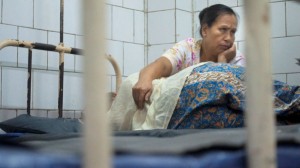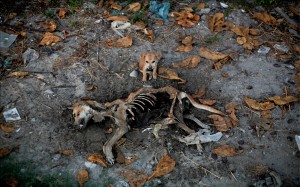
The new generation of photo journalists in Myanmar: A time to document history
He started out as an award-winning classical pianist, but sold his piano to buy a camera. A few months later, he had his first international breakthrough and now belongs to the new generation of photo journalists in Myanmar set on documenting history in their country. IMS meets Min Zayar Oo in his hometown Yangon
By Helle Wahlberg, IMS
It’s the eve of the Yangon Photo Festival awards night. Min Zayar Oo sits in the small café of the French Cultural Institute in Yangon waiting in anticipation for the ceremony to begin. He still has trouble believing the direction that his life has taken at the age of 26 since he followed political icon Aung San Suu Kyi on her country-wide campaign trail for by-elections in March 2012. His photographer friend from Reuters was unable to travel to the south of the country with The Lady, as she is known in Myanmar, and instead asked Min Zayar to capture some shots of her. His opening to Reuters was thus established and and a photo taken by him two weeks later during another stretch of her campaign trail ended up on the front page of the Herald Tribune and became his big, international break.
“In 2011 when I began taking photos, I primarily focused on landscape photography,” Min Zayar explains. “But in my father’s print shop I had seen photos in various NGO and UN reports of social and humanitarian issues, of children, women, health, etc. So I also wanted to take pictures of something more important, powerful, but I didn’t know where to start. Through a friend I heard about workshops in photo journalism run by French photographer Christophe Loviny and these workshops changed my view on photography.”
It’s about the message – not the camera
Photo journalism is a particular form of journalism that creates images in order to tell a news story. At the workshops held in central Yangon by International Media Support (IMS) for young untrained photographers, some of whom had never before held a camera, the students were asked to tell a story through a series of images on a topic of their own choice.
“I always thought a good picture was about technique, the blurring of backgrounds, having the best camera. But the workshops taught me that it is not about the camera. It is about the subject, about the message you want to convey with your photos and about ensuring that this message is important for the subject of your pictures.”
Snuck into government hospital

In his first workshop photo essay, Min Zayar wanted to depict the struggle of giving birth in a series of beautiful and emotional photographs. His background as a medical student and his contacts enabled him to slip unnoticed into the birthing unit of the Yangon General Hospital, a daring and forbidden location at the time. Over a period of time he hid in the birthing unit with help from the women where he took photos with a small, compact camera.
“When I brought back the first series of photos of women with their babies to show in the workshop, what interested Christophe Loviny [photographer running the workshop] and my fellow students was not the colour and technique of my pictures. It was the fact that the photos showed the unhygienic conditions in which women were giving birth in a government hospital. This is when I realised that it is not about technique, it is about the message of the photo,” explains Min Zayar.
Although the photos were not published in media inside Myanmar due to the sensitive subject matter, the photos were shared on the Internet and circulated outside the country. With this photo essay, Min Zayar realised there were things about his country he wanted to tell the outside world.
Conditions for photography slowly changing
Depicting the lives of everyday people, their living conditions, conflicts in the country and government institutions has for years been a sensitive undertaking in Myanmar and remains so, although things are slowly changing. Since 2009, IMS has trained over 100 photo journalists in the art of telling stories with photos through workshops tied to the Yangon Photo Festival which could only be discussed openly for the first time in 2012 when government reforms were set in motion.
“One day, under the previous military government, my friend and I set up our tripod in a traffic crossing to take pictures of street traders. A policeman came to tell us that we could not take pictures there because a VIP was due to drive past us, so we were asked to pack up and leave. This incident made me so nervous that I didn’t take photos for weeks.
“Also, many ordinary people are not comfortable with other locals taking pictures of them. They do not like it. When a camera lens points at them they are worried the photos will be used against them, that the photos will be used to report them to the authorities for some misdemeanor. This is slowly changing, but many remain uncertain about having their picture taken, says Min Zayar.
There is little history of photo journalism in Myanmar with many photographers accustomed only to taking landscape and portrait pictures, according to Min Zayar. The Myanmar Photography Society has no division for photo journalism and therefore many people do not know how to go about documentary photography.
“After years of beautiful landscape photography, many find it hard to take photos of the ugliness in the streets, Min Zayar explains.”
Documenting history
In 2011, when Aung Sang Suu Kyi had been released from house arrest and later embarked on her by-election campaign tour that took her to different parts of Myanmar, Min Zayar decided to do a photo essay on the subject of “Hope”, interviewing people on the street with different backgrounds about their hopes for the future. He showed these photos to Aung Suu Kyi, when she visited the Yangon Photo Festival in 2011 as its patron. He then embarked on the campaign trail with her, deciding he had to document an important piece of history.
The “Hope” photo series won him an award at the photo festival in 2012 as did his more recent photo series of the devastation caused in Rakhine State at the 2013 Yangon Photo Festival (“Mini-Singapore”). Especially one photo, that of a puppy lingering at the side of the remains of its dead mother burnt in the battle between the Rakhine people and those of Muslim background, resonated outside Myanmar and led to a series of blogs on the NBC website about what happened to the puppy, showing the impact of how one photo alone can tell a story.

“I had to do something and made sure the puppy went to a nearby monastery. It’s not just about photography. It was a good shot, but I cannot say I am very happy. The story behind it is tragic and it is difficult.”
Min Zayar explains that the responsibility tied to taking photographs is important and is something the students are taught in the workshops.
“You need to tell a story that is important for your subject and think about the consequences of your photographs. It’s not only about photography. It is about the message.”
Read more about the Yangon Photo Festival 2013 here or International Media Support’s work in Myanmar to support the development of media.




